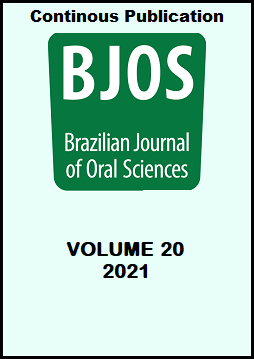Abstract
Aim: Evaluation of the reliability of 3D computed tomography (3D-CT) in the diagnosis of mandibular fractures. Methods: A cross-sectional, quantitative and qualitative study was carried out, through the application of a questionnaire for 70 professionals in the area of Oral and Maxillofacial Surgery and Radiology. 3D-CT images of mandibular fractures were delivered to the interviewees along with a questionnaire. Participants answered about the number of traces, the region and the type of fracture. The correct diagnosis, that is, the expected answer, was based on the reports of a specialist in oral and maxillofacial radiology after viewing the images in the axial, sagittal and coronal sections. The resulting data from the interviewees was compared with the expected answer and then, the data was analyzed statistically. Results: In the sample 56.9% were between 22 and 30 years old, 52.8% were oral and maxillofacial surgeons (OMF), 34.7% were residents in OMF surgery and 12.5% OMF radiologists. Each professional answered 15 questions (related to five patients) and 50.8% of the total of these was answered correctly. Specialists in Oral and Maxillofacial Surgery and Traumatology correctly answered 53.9%. Interviewees with experience between 6 and 10 years correctly answered 58.2%. In identifying fracture traces, 46.1% of the questions were answered correctly. In terms of location, 5.6% of interviewees answered wrongly while 14.2% answered wrongly regarding classification. Conclusion: 3D computed tomography did not prove to be a reliable image for diagnosing mandibular fractures when used alone. This made necessary an association with axial, sagittal and coronal tomographic sections.
References
Shintaku WH, Venturin JS, Azevedo B, Noujeim M. Applications of cone-beam computed tomography in fractures of the maxillofacial complex. Dent Traumatol. 2009;25(4):358-66. doi: 10.1111/j.1600-9657.2009.00795.x.
Bai L, Li L, Su K, Bleyer A, Zhang Y, Ji P. 3D reconstruction images of cone beam computed tomography applied to maxillofacial fractures: A case study and mini review. J Xray Sci Technol. 2018;26(1):115-23. doi: 10.3233/XST-17342.
Aydin U, Gormez O, Yildirim D. Cone-beam computed tomography imaging of dentoalveolar and mandibular fractures. Oral Radiol. 2019;(0123456789):23-8. doi: 10.1007/s11282-019-00390-5.
Saigal K, Winokur RS, Finden S, Taub D, Pribitkin E. Use of three-dimensional computerized tomography reconstruction in complex facial trauma. Facial Plast Surg. 2005;21(3):214-9. doi: 10.1055/s-2005-922862.
Jarrahy R, Vo V, Goenjian HA, Tabit CJ, Katchikian H V, Kumar A, et al. Diagnostic accuracy of maxillofacial trauma two-dimensional and three-dimensional computed tomographic scans: comparison of oral surgeons, head and neck surgeons, plastic surgeons, and neuroradiologists. Plast Reconstr Surg. 2011;127(6):2432-40. doi: 10.1097/PRS.0b013e318213a1fe.
Nardi C, Vignoli C, Pietragalla M, Tonelli P, Calistri L, Franchi L, et al. Imaging of mandibular fractures: a pictorial review. Insights Imaging. 2020;11(1). doi: 10.1186/s13244-020-0837-0.
Manson PN, Markowitz B, Mirvis S, Dunham M, Yaremchuk M. Toward CT-based facial fracture treatment (Letter). Plast Reconstr Surg. 1990 Oct;86(4):806.
Dediol E. The role of three-dimensional computed tomography in evaluating facial trauma. Plast Reconstr Surg 2012;129(2):354-5. doi: 10.1097/PRS.0b013e31823aee2f.
Kaur J, Chopra R. Three Dimensional CT Reconstruction for the evaluation and surgical planning of mid face fractures: a 100 case study. J Maxillofac Oral Surg. 2010;9(4):323-8. doi: 10.1007/s12663-010-0137-1.
Fox LA, Vannier MW, West OC, Wilson AJ, Baran GA, Pilgram TK. Diagnostic performance of CT, MPR and 3DCT imaging in maxillofacial trauma. Comput Med Imaging Graph. 1995;19(5):385-95. doi: 10.1016/0895-6111(95)00022-4.
Shah S, Uppal SK, Mittal RK, Garg R, Saggar K, Dhawan R. Diagnostic tools in maxillofacial fractures: Is there really a need of three-dimensional computed tomography? Indian J Plast Surg. 2016;49(2):225-33. doi: 10.4103/0970-0358.191320.
Perandini S, Faccioli N, Zaccarella A, Re T, Mucelli R. The diagnostic contribution of CT volumetric rendering techniques in routine practice. Indian J Radiol Imaging. 2010;20(2):92-7. doi: 10.4103/0971-3026.63043.
Wolff C, Mücke T, Wagenpfeil S, Kanatas A, Bissinger O, Deppe H. Do CBCT scans alter surgical treatment plans? Comparison of preoperative surgical diagnosis using panoramic versus cone-beam CT images. J Cranio-Maxillofacial Surg. 2016;44(10):1700-5. doi: 10.1016/j.jcms.2016.07.025.
Kaeppler G, Cornelius CP, Ehrenfeld M, Mast G. Diagnostic efficacy of cone-beam computed tomography for mandibular fractures. Oral Surg Oral Med Oral Pathol Oral Radiol. 2013;116(1):98-104. doi: 10.1016/j.oooo.2013.04.004.
Sales MAO, Gaia BF, Perrela A, Cavalcanti MGP. Comparison between multislice and cone-beam computed tomography for the identification of simulated bone lesions using 3D reconstruction. Rev Odonto Cienc. 2013;28(2):47-52.
Severo FC, Barbosa GF. Risk factors and success rates associated with orthodontic mini-implants: a literature review. Rev Odonto Cienc. 2015;30(4):200-4. doi: 10.15448/1980-6523.2015.4.15801.
Kim DO, Kim HJ, Jung H, Jeong HK, Hong S Il, Kim KD. Quantitative evaluation of acquisition parameters in three-dimensional imaging with multidetector computed tomography using human skull phantom. J Digit Imaging. 2002;15 Suppl 1(4):254-7. doi: 10.1007/s10278-002-5054-5.

This work is licensed under a Creative Commons Attribution 4.0 International License.
Copyright (c) 2021 Brazilian Journal of Oral Sciences


